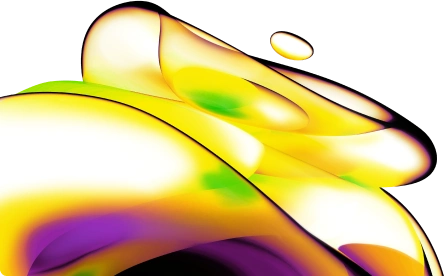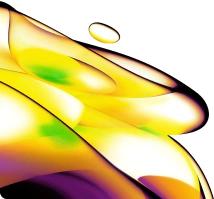

AlphaLISA SureFire Ultra Human and Mouse Phospho-SYK (Tyr525/526) Detection Kit, 500 Assay Points
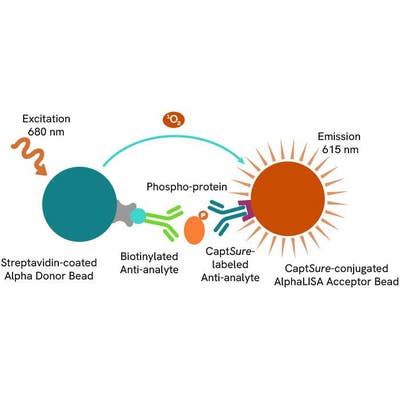
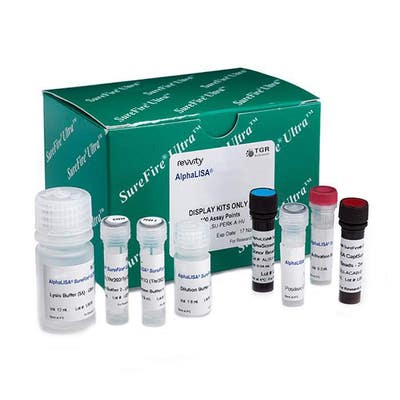
 View All
View All
AlphaLISA SureFire Ultra Human and Mouse Phospho-SYK (Tyr525/526) Detection Kit, 500 Assay Points
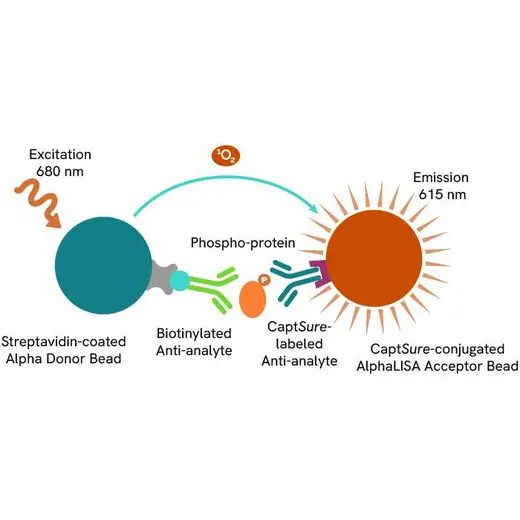





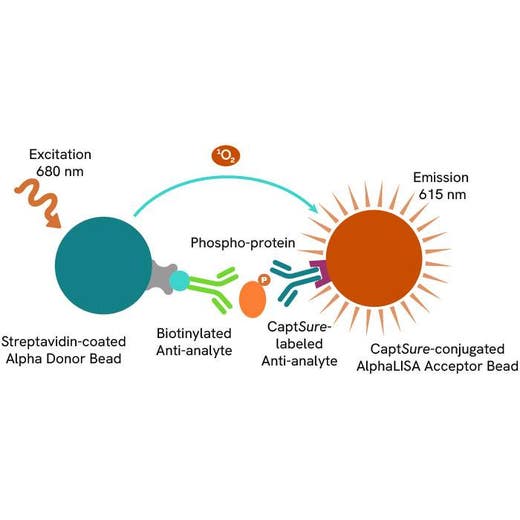
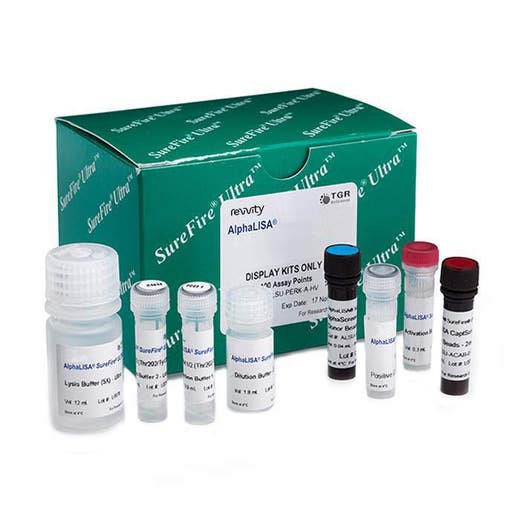




The AlphaLISA™ SureFire® Ultra™ p-SYK (Tyr525/526) assay is a sandwich immunoassay for quantitative detection of phospho-SYK (phosphorylated on Tyr525/526) in cellular lysates using Alpha Technology.
| Feature | Specification |
|---|---|
| Application | Cell Signaling |
| Sample Volume | 10 µL |
The AlphaLISA™ SureFire® Ultra™ p-SYK (Tyr525/526) assay is a sandwich immunoassay for quantitative detection of phospho-SYK (phosphorylated on Tyr525/526) in cellular lysates using Alpha Technology.






AlphaLISA SureFire Ultra Human and Mouse Phospho-SYK (Tyr525/526) Detection Kit, 500 Assay Points






AlphaLISA SureFire Ultra Human and Mouse Phospho-SYK (Tyr525/526) Detection Kit, 500 Assay Points






Loading...
Product information
Overview
SYK (Spleen Tyrosine Kinase) is a crucial non-receptor tyrosine kinase in various signaling pathways, particularly in immune cell activation and regulation. In both humans and mice, SYK plays a central role in diverse cellular processes, including B-cell receptor (BCR) signaling, Fc receptor signaling, and integrin-mediated responses. Activation of SYK occurs through phosphorylation at key tyrosine residues, with Tyr525/526 being particularly important for full kinase activity and downstream signaling. SYK signaling is frequently implicated in various diseases, especially in hematological malignancies, autoimmune disorders, allergic conditions, and neurodegenerative diseases where aberrant activation of the pathway contributes to disease progression and immune dysregulation.
The AlphaLISA SureFire Ultra Human & Mouse Phospho-SYK (Tyr525/526) Detection Kit is sensitive sandwich immunoassay designed for the quantitative detection of phosphorylated SYK (Tyr525/526) in cellular lysates from both human and mouse samples, using Alpha technology.
Formats:
- The HV (high volume) kit contains reagents to run 100 wells in 96-well format, using a 60 μL reaction volume.
- The 500-point kit contains enough reagents to run 500 wells in 384-well format, using a 20 μL reaction volume.
- The 10,000-point kit contains enough reagents to run 10,000 wells in 384-well format, using a 20 μL reaction volume.
- The 50,000-point kit contains enough reagents to run 50,000 wells in 384-well format, using a 20 μL reaction volume.
AlphaLISA SureFire Ultra kits are compatible with:
- Cell and tissue lysates
- Antibody modulators
- Biotherapeutic antibodies
Alpha SureFire kits can be used for:
- Cellular kinase assays
- Receptor activation studies
- Screening
Specifications
| Application |
Cell Signaling
|
|---|---|
| Automation Compatible |
Yes
|
| Brand |
AlphaLISA SureFire Ultra
|
| Detection Modality |
Alpha
|
| Lysis Buffer Compatibility |
Lysis Buffer
|
| Molecular Modification |
Phosphorylation
|
| Product Group |
Kit
|
| Sample Volume |
10 µL
|
| Shipping Conditions |
Shipped in Blue Ice
|
| Target |
SYK
|
| Target Class |
Phosphoproteins
|
| Target Species |
Human
Mouse
|
| Technology |
Alpha
|
| Unit Size |
500 assay points
|
Video gallery


AlphaLISA SureFire Ultra Human and Mouse Phospho-SYK (Tyr525/526) Detection Kit, 500 Assay Points


AlphaLISA SureFire Ultra Human and Mouse Phospho-SYK (Tyr525/526) Detection Kit, 500 Assay Points


How it works
Phospho-AlphaLISA SureFire Ultra assay principle
The Phospho-AlphaLISA SureFire Ultra assay measures a protein target when phosphorylated at a specific residue.
The assay uses two antibodies which recognize the phospho epitope and a distal epitope on the targeted protein. AlphaLISA assays require two bead types: Acceptor and Donor beads. Acceptor beads are coated with a proprietary CaptSure™ agent to specifically immobilize the assay specific antibody, labeled with a CaptSure™ tag. Donor beads are coated with streptavidin to capture one of the detection antibodies, which is biotinylated. In the presence of phosphorylated protein, the two antibodies bring the Donor and Acceptor beads in close proximity whereby the singlet oxygen transfers energy to excite the Acceptor bead, allowing the generation of a luminescent Alpha signal. The amount of light emission is directly proportional to the quantity of phosphoprotein present in the sample.

AlphaLISA SureFire Ultra two-plate assay protocol
The two-plate protocol involves culturing and treating the cells in a 96-well plate before lysis, then transferring lysates into a 384-well OptiPlate™ plate before the addition of Phospho-AlphaLISA SureFire Ultra detection reagents. This protocol permits the cells' viability and confluence to be monitored. In addition, lysates from a single well can be used to measure multiple targets.
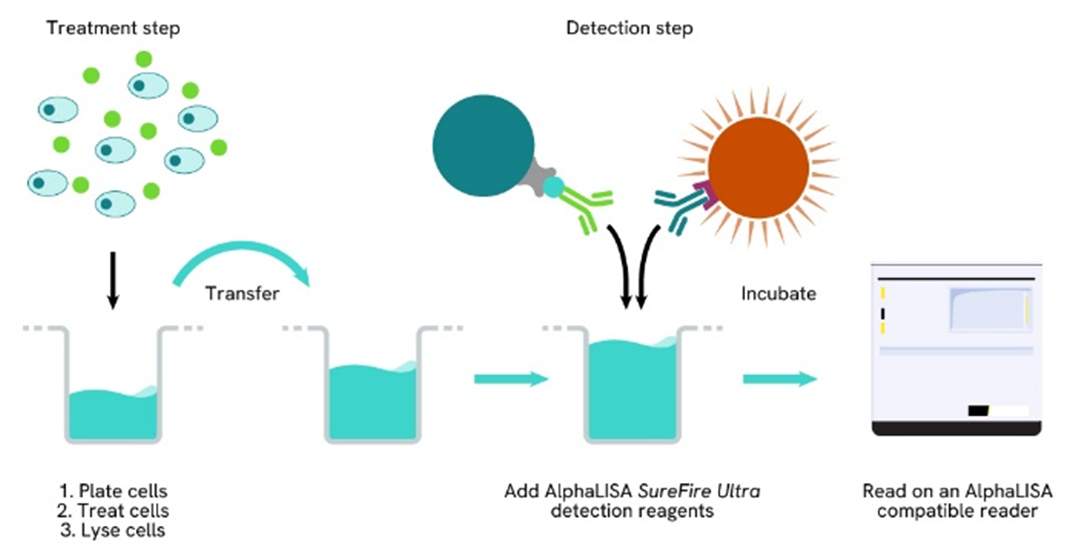
Phospho-AlphaLISA SureFire Ultra one-plate assay protocol
Detection of Phosphorylated target protein with AlphaLISA SureFire Ultra reagents can be performed in a single plate used for culturing, treatment, and lysis. No washing steps are required. This HTS designed protocol allows for miniaturization while maintaining AlphaLISA SureFire Ultra quality.
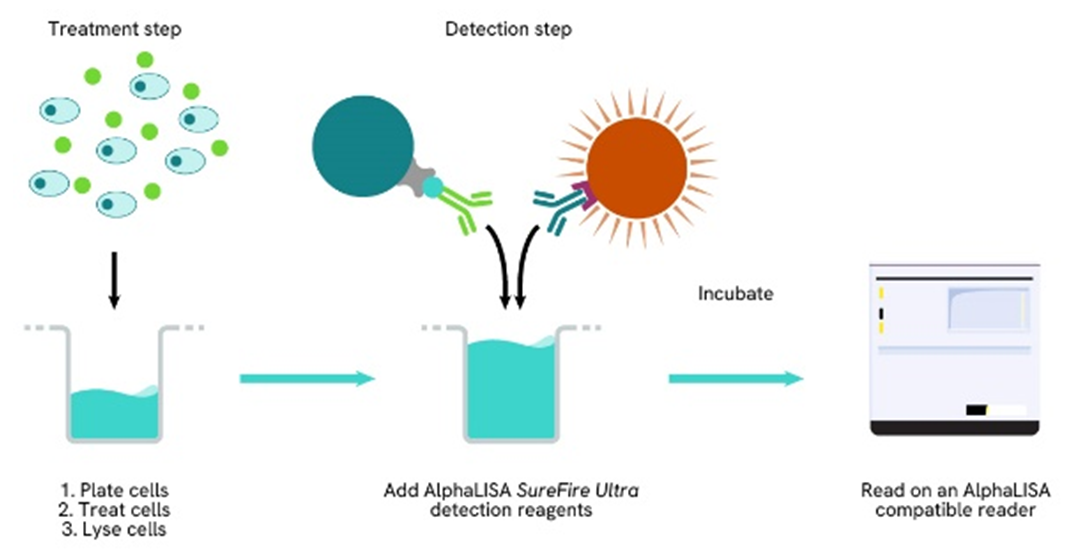
Assay validation
TREM2 Activator rapidly induces SYK phosphorylation in THP-1 and primary macrophages
THP-1 cells were treated with 35 ng/mL TGFb for 18 hours at 37°C, 5% CO2. Cells were harvested and seeded in a 96-well plate (400,000 cells/well) in HBSS + 0.1% BSA and then treated with 20 µM TREM2 Activator (MedChemExpress, Cat # HY-148095) for various time points.
After treatment, cells were lysed with the addition of 50 µL of 5X Lysis Buffer for 10 minutes at RT with shaking (350 rpm). SYK Phospho (Tyr525/526) levels were evaluated by AlphaLISA SureFire Ultra. For the detection step, 10 µL of cell lysate (approximately 16,000 cells) were transferred into a 384-well white OptiPlate, followed by 5 µL of Acceptor mix and incubated for 1 hour at RT. Finally, 5 µL of Donor mix was then added to each well and incubated for 1 hour at RT in the dark.
TREM2 activator induced SYK phosphorylation within just 2 minutes, peaking at 10 minutes of treatment.
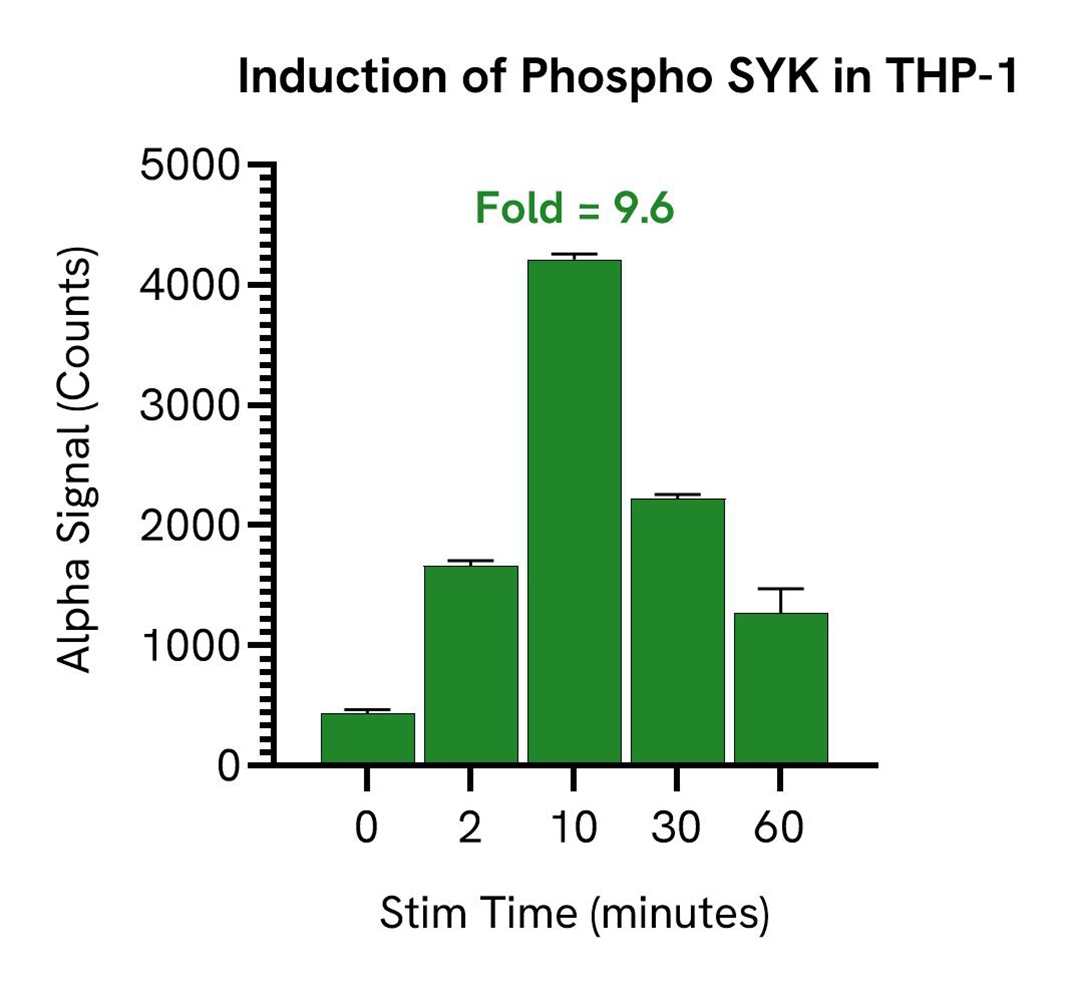
PBMCs were isolated from healthy donors and cultured for 6 days in complete DMEM containing 20 ng/mL M-CSF to differentiate them into macrophages. Macrophages were seeded in a 96-well plate (40,000 cells/well) in complete DMEM, and incubated overnight at 37°C, 5% CO2. Cells were treated with 35 ng/mL TGFb for 18 hours and then treated with 20 µM TREM2 Activator (MedChemExpress, Cat # HY-148095) for various time points.
After treatment, cells were lysed in 50 µL of Lysis Buffer for 10 minutes at RT with shaking (350 rpm). SYK Phospho (Tyr525/526) levels were evaluated by AlphaLISA SureFire Ultra. For the detection step, 10 µL of cell lysate (approximately 8,000 cells) were transferred into a 384-well white OptiPlate, followed by 5 µL of Acceptor mix and incubated for 1 hour at RT. Finally, 5 µL of Donor mix was then added to each well and incubated for 1 hour at RT in the dark.
As expected, TREM2 activator induced SYK phosphorylation very quickly, peaking at 10 minutes post- treatment.
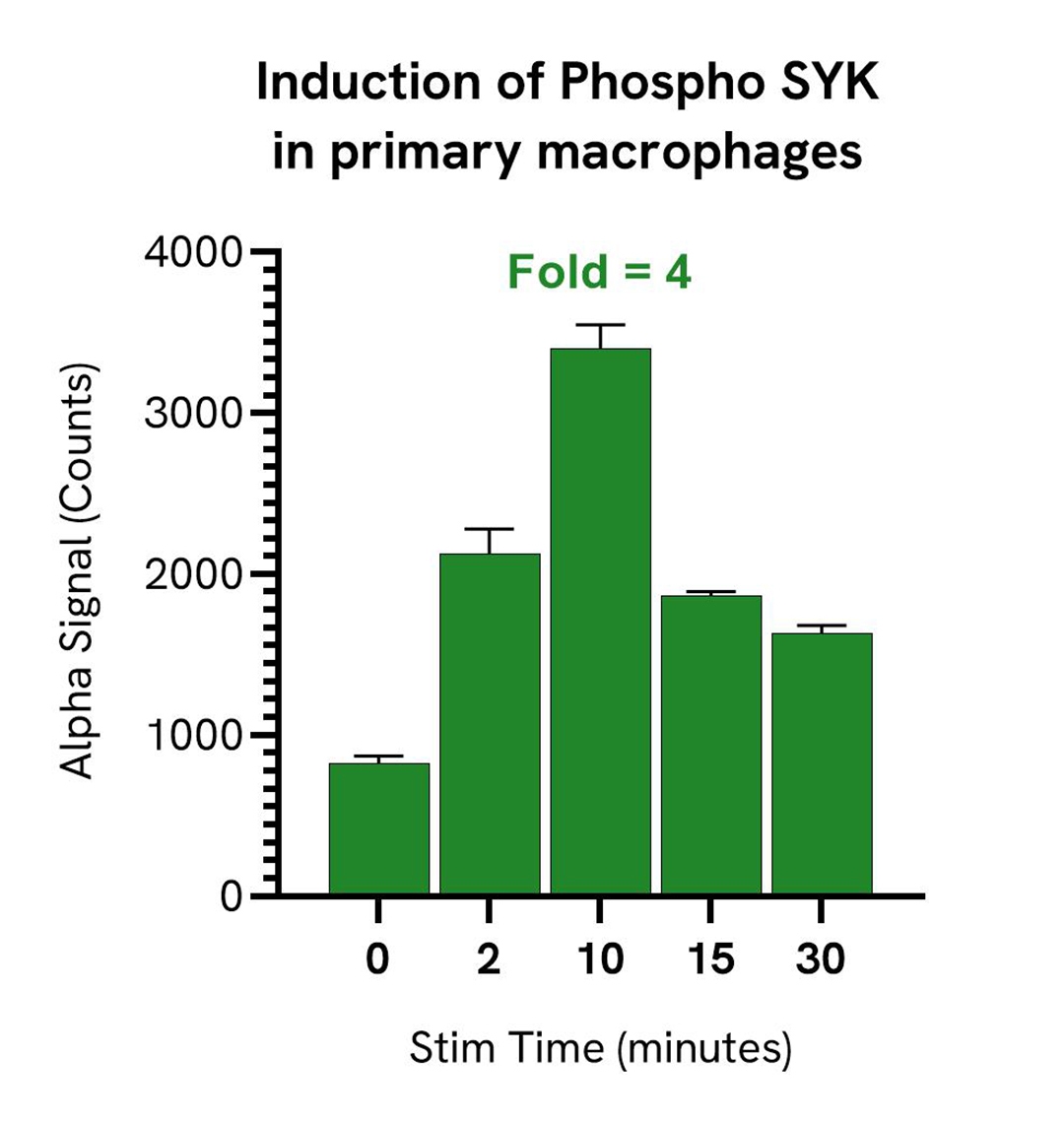
Concanavalin A induces SYK phosphorylation in THP-1 cells
THP-1 cells were seeded in a 96-well plate (200,000 cells/well) in HBSS + 0.1% BSA and treated with increasing concentrations of Concanavalin A for 10 minutes.
After treatment, the cells were spun down at 300 RCF for 5 minutes, treatment removed and then lysed with 100 µL Lysis Buffer for 10 minutes at RT with shaking (350 rpm). Phospho (Tyr525/526) and Total SYK levels were evaluated using respective AlphaLISA SureFire Ultra assays. For the detection step, 10 µL of cell lysate (approximately 20,000) was transferred into a 384-well white OptiPlate, followed by 5 µL of Acceptor mix and incubated for 1 hour at RT. Finally, 5 µL of Donor mix was then added to each well and incubated for 1 hour at RT in the dark. The plate was read on an Envision using standard AlphaLISA settings.
As expected, Concanavalin A triggered a dose-dependent increase in the levels of Phospho SYK (Tyr525/526) while Total SYK levels remained unchanged.
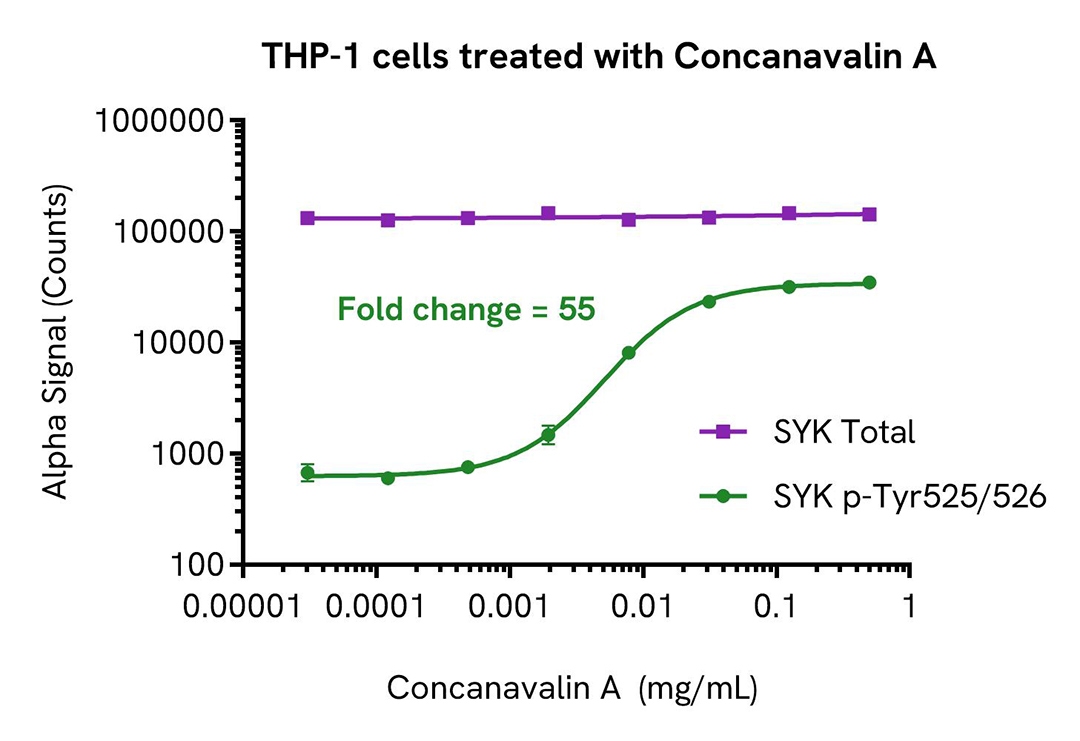
Activation of Phospho SYK (Tyr525/526) levels in Anti-IgM treated cells
Ramos cells were seeded in a 96-well plate (300,000 cells/well) in HBSS + 0.1% HBSS and treated with 20 µg/mL Anti-IgM for 15 minutes.
After treatment, the cells were lysed with the addition of 50 µL of 5x Lysis Buffer for 10 minutes at RT with shaking (350 rpm). Phospho (Tyr525/526) SYK levels were evaluated by AlphaLISA SureFire Ultra. For the detection step, 10 µL of cell lysate (approximately 12,000 cells was transferred into a 384-well white OptiPlate, followed by 5 µL of Acceptor mix and incubated for 1 hour at RT. Finally, 5 µL of Donor mix was then added to each well and incubated for 1 hour at RT in the dark. The plate was read on an Envision using standard AlphaLISA settings.
As expected, Anti-IgM triggered an increase in the levels of Phospho (Tyr525/526) SYK.
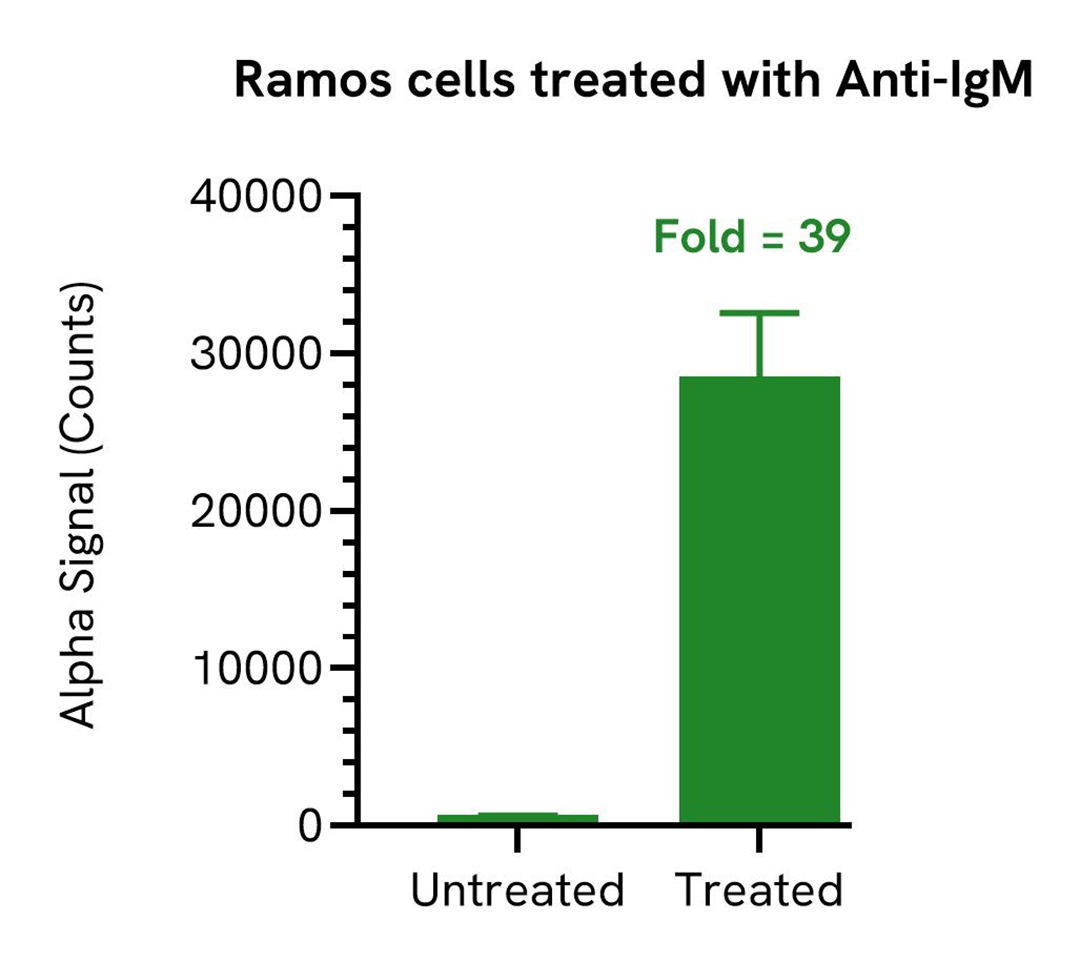
Resources
Are you looking for resources, click on the resource type to explore further.
This guide outlines further possible optimization of cellular and immunoassay parameters to ensure the best possible results are...
This application note explores how the AlphaLISA™ SureFire® Ultra™ technology reveals the intricacies of TREM2/DAP12 signaling in...
The definitive guide for setting up a successful AlphaLISA SureFire Ultra assay
Several biological processes are regulated by...
Discover Alpha SureFire® Ultra™ assays, the no-wash cellular kinase assays leveraging Revvity's exclusive bead-based technology...
The measurement of protein phosphorylation is a useful tool for measuring the modulation of receptor activation by both antibodies...
Advance your autoimmune disease research and benefit from Revvity broad offering of reagent technologies
Loading...


How can we help you?
We are here to answer your questions.
